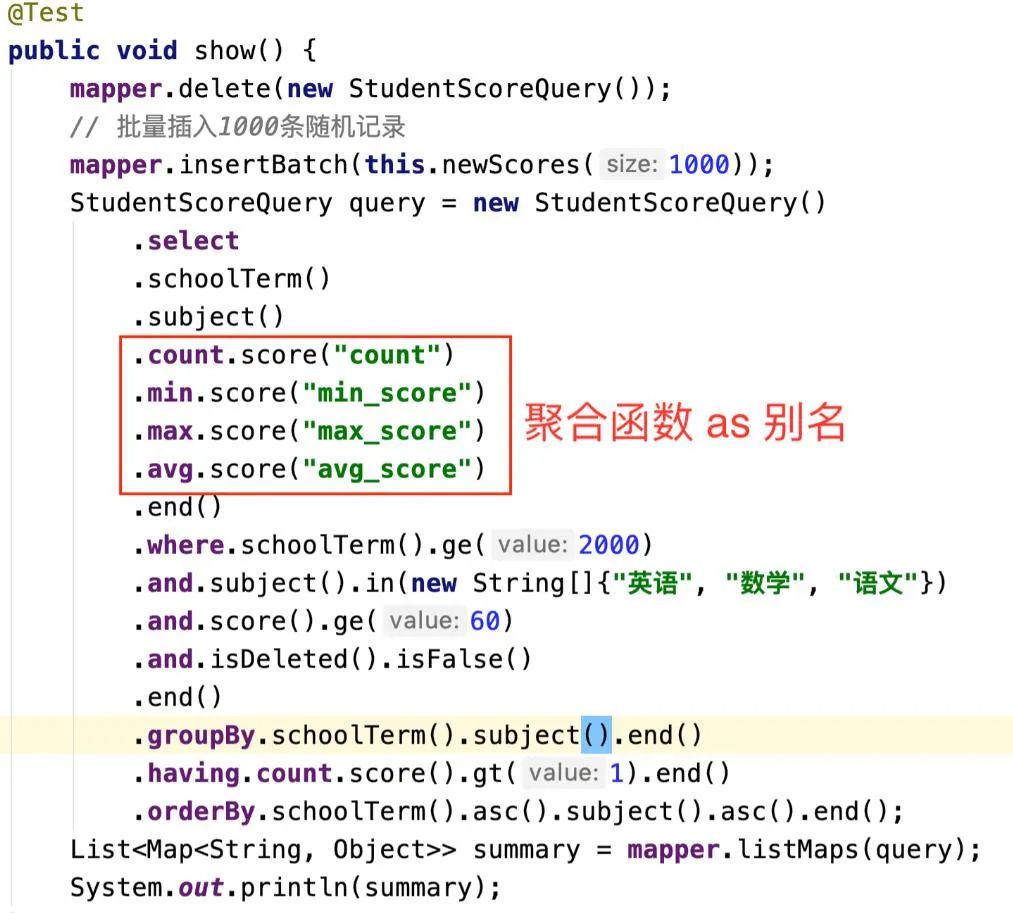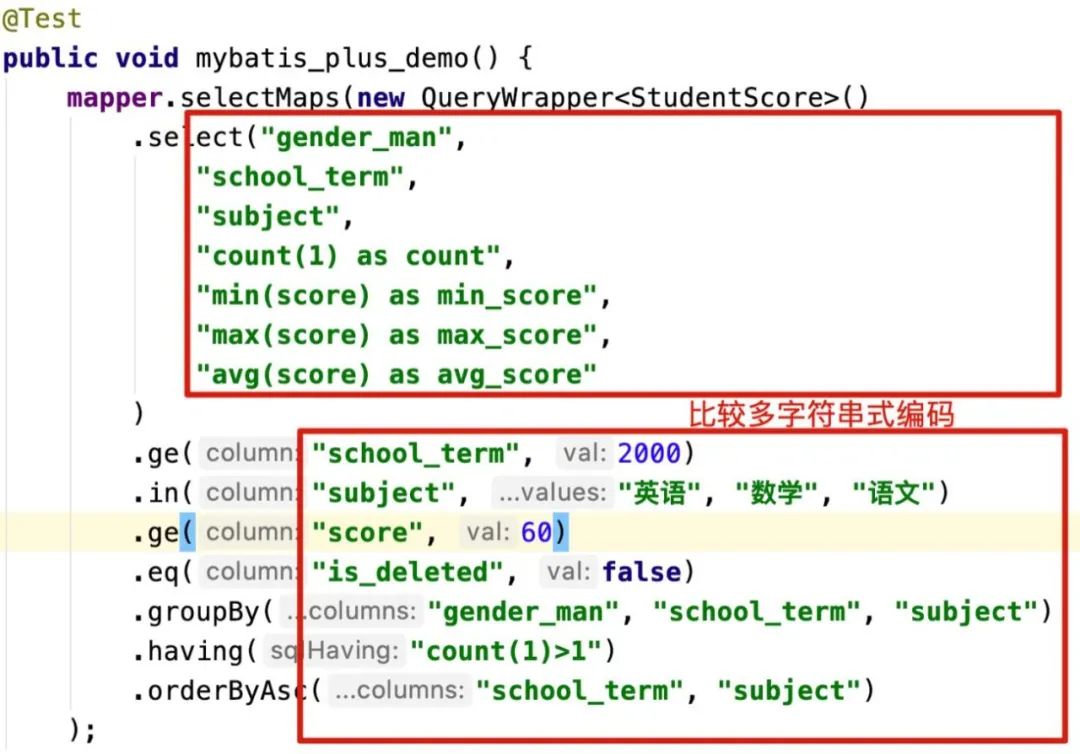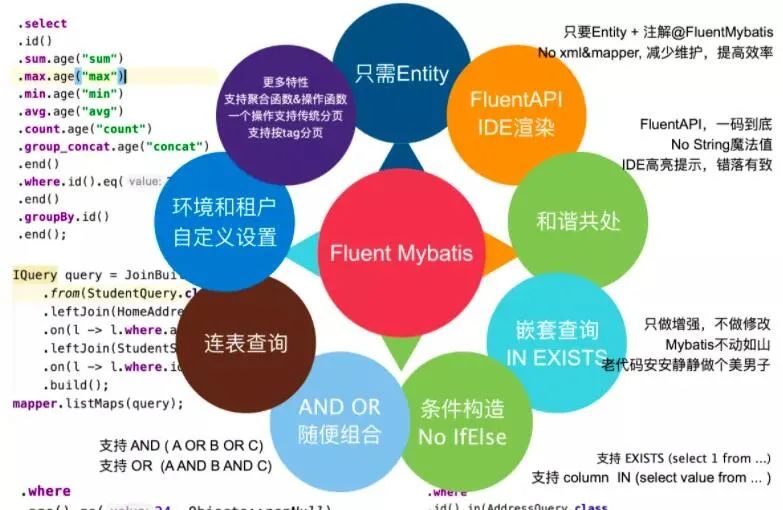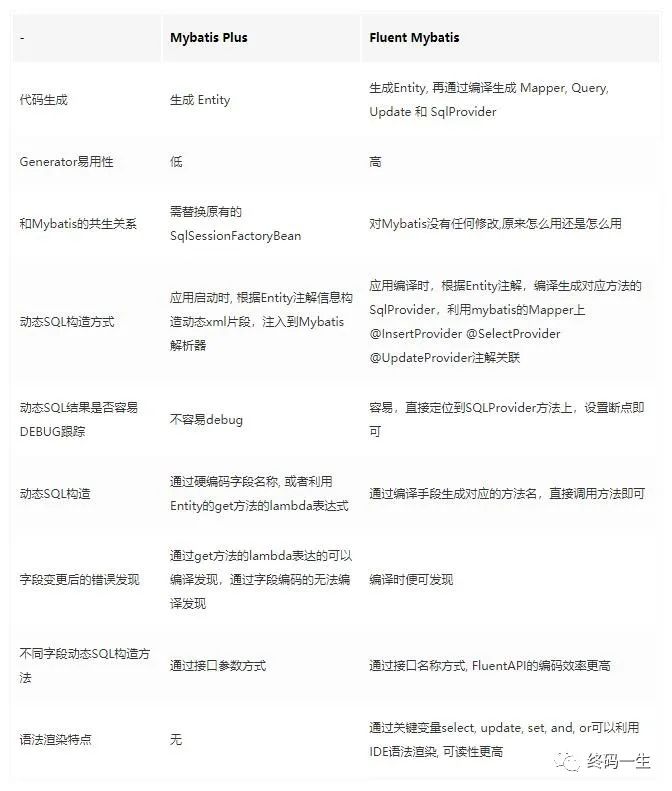-
【转存】 fluent mybatis 与Mybatis 简答介绍
感谢:IT码徒 提供 原文请关注

前言
使用fluent mybatis也可以不用写具体的 xml 文件,通过 java api 可以构造出比较复杂的业务 sql 语句,做到代码逻辑和 sql 逻辑的合一。不再需要在 Dao 中组装查询或更新操作,或在 xml 与 mapper 中再组装参数。那对比原生 Mybatis,Mybatis Plus 或者其他框架,Fluent Mybatis提供了哪些便利呢?
需求场景设置
我们通过一个比较典型的业务需求来具体实现和对比下,假如有学生成绩表结构如下:
- create table `student_score`
- (
- id bigint auto_increment comment '主键ID' primary key,
- student_id bigint not null comment '学号',
- gender_man tinyint default 0 not null comment '性别, 0:女; 1:男',
- school_term int null comment '学期',
- subject varchar(30) null comment '学科',
- score int null comment '成绩',
- gmt_create datetime not null comment '记录创建时间',
- gmt_modified datetime not null comment '记录最后修改时间',
- is_deleted tinyint default 0 not null comment '逻辑删除标识'
- ) engine = InnoDB default charset=utf8;
现在有需求:
「统计 2000 年三门学科('英语', '数学', '语文')及格分数按学期,学科统计最低分,最高分和平均分, 且样本数需要大于 1 条,统计结果按学期和学科排序」
我们可以写 SQL 语句如下
- select school_term,
- subject,
- count(score) as count,
- min(score) as min_score,
- max(score) as max_score,
- avg(score) as max_score
- from student_score
- where school_term >= 2000
- and subject in ('英语', '数学', '语文')
- and score >= 60
- and is_deleted = 0
- group by school_term, subject
- having count(score) > 1
- order by school_term, subject;
那上面的需求,分别用fluent mybatis, 原生mybatis和Mybatis plus来实现一番。
三者实现对比
使用fluent mybatis 来实现上面的功能

我们可以看到fluent api的能力,以及 IDE 对代码的渲染效果。
换成mybatis原生实现效果
-
定义Mapper接口
- public interface MyStudentScoreMapper {
- List<Map<String, Object>> summaryScore(SummaryQuery paras);
- }
-
定义接口需要用到的参数实体 SummaryQuery
- @Data
- @Accessors(chain = true)
- public class SummaryQuery {
- private Integer schoolTerm;
- private List<String> subjects;
- private Integer score;
- private Integer minCount;
- }
-
定义实现业务逻辑的mapper xml文件
- <select id="summaryScore" resultType="map" parameterType="cn.org.fluent.mybatis.springboot.demo.mapper.SummaryQuery">
- select school_term,
- subject,
- count(score) as count,
- min(score) as min_score,
- max(score) as max_score,
- avg(score) as max_score
- from student_score
- where school_term >= #{schoolTerm}
- and subject in
- <foreach collection="subjects" item="item" open="(" close=")" separator=",">
- #{item}
- </foreach>
- and score >= #{score}
- and is_deleted = 0
- group by school_term, subject
- having count(score) > #{minCount}
- order by school_term, subject
- </select>
-
实现业务接口(这里是测试类,实际应用中应该对应 Dao 类)
- @RunWith(SpringRunner.class)
- @SpringBootTest(classes = QuickStartApplication.class)
- public class MybatisDemo {
- @Autowired
- private MyStudentScoreMapper mapper;
- @Test
- public void mybatis_demo() {
- // 构造查询参数
- SummaryQuery paras = new SummaryQuery()
- .setSchoolTerm(2000)
- .setSubjects(Arrays.asList("英语", "数学", "语文"))
- .setScore(60)
- .setMinCount(1);
- List<Map<String, Object>> summary = mapper.summaryScore(paras);
- System.out.println(summary);
- }
- }
总之,直接使用 mybatis,实现步骤还是相当的繁琐,效率太低。那换成mybatis plus的效果怎样呢?
换成Mybaits原生实现效果
mybatis plus的实现比mybatis会简单比较多,实现效果如下

如红框圈出的,写mybatis plus实现用到了比较多字符串的硬编码(可以用 Entity 的 get lambda 方法部分代替字符串编码)。字符串的硬编码,会给开发同学造成不小的使用门槛,个人觉的主要有 2 点:
-
字段名称的记忆和敲码困难
-
Entity 属性跟随数据库字段发生变更后的运行时错误
其他框架,比如TkMybatis在封装和易用性上比mybatis plus要弱,就不再比较了。
4
生成代码编码比较
fluent mybatis生成代码设置
- public class AppEntityGenerator {
- static final String url = "jdbc:mysql://localhost:3306/fluent_mybatis_demo?useSSL=false&useUnicode=true&characterEncoding=utf-8";
- public static void main(String[] args) {
- FileGenerator.build(Abc.class);
- }
- @Tables(
- /** 数据库连接信息 **/
- url = url, username = "root", password = "password",
- /** Entity类parent package路径 **/
- basePack = "cn.org.fluent.mybatis.springboot.demo",
- /** Entity代码源目录 **/
- srcDir = "spring-boot-demo/src/main/java",
- /** Dao代码源目录 **/
- daoDir = "spring-boot-demo/src/main/java",
- /** 如果表定义记录创建,记录修改,逻辑删除字段 **/
- gmtCreated = "gmt_create", gmtModified = "gmt_modified", logicDeleted = "is_deleted",
- /** 需要生成文件的表 ( 表名称:对应的Entity名称 ) **/
- tables = @Table(value = {"student_score"})
- )
- static class Abc {
- }
- }
Mybatis Plus代码生成设置
- public class CodeGenerator {
- static String dbUrl = "jdbc:mysql://localhost:3306/fluent_mybatis_demo?useSSL=false&useUnicode=true&characterEncoding=utf-8";
- @Test
- public void generateCode() {
- GlobalConfig config = new GlobalConfig();
- DataSourceConfig dataSourceConfig = new DataSourceConfig();
- dataSourceConfig.setDbType(DbType.MYSQL)
- .setUrl(dbUrl)
- .setUsername("root")
- .setPassword("password")
- .setDriverName(Driver.class.getName());
- StrategyConfig strategyConfig = new StrategyConfig();
- strategyConfig
- .setCapitalMode(true)
- .setEntityLombokModel(false)
- .setNaming(NamingStrategy.underline_to_camel)
- .setColumnNaming(NamingStrategy.underline_to_camel)
- .setEntityTableFieldAnnotationEnable(true)
- .setFieldPrefix(new String[]{"test_"})
- .setInclude(new String[]{"student_score"})
- .setLogicDeleteFieldName("is_deleted")
- .setTableFillList(Arrays.asList(
- new TableFill("gmt_create", FieldFill.INSERT),
- new TableFill("gmt_modified", FieldFill.INSERT_UPDATE)));
- config
- .setActiveRecord(false)
- .setIdType(IdType.AUTO)
- .setOutputDir(System.getProperty("user.dir") + "/src/main/java/")
- .setFileOverride(true);
- new AutoGenerator().setGlobalConfig(config)
- .setDataSource(dataSourceConfig)
- .setStrategy(strategyConfig)
- .setPackageInfo(
- new PackageConfig()
- .setParent("com.mp.demo")
- .setController("controller")
- .setEntity("entity")
- ).execute();
- }
- }
5
FluentMybatis特性一览

三者对比总结
看完 3 个框架对同一个功能点的实现, 各位看官肯定会有自己的判断,笔者这里也总结了一份比较。

好了,今天就介绍到这里,这里只是简单的对比三个ORM框架的区别,如果有对 Fluent Mybatis 感兴趣的小伙伴,可以去阅读官方源码,发现更多新大陆哦!
-
相关阅读:
对 Vue 中虚拟 DOM 的理解及其原理
Java高性能解析器实现思路及方法
FFmpeg的详细介绍
Java 如何让HashMap集合按照value进行排序呢?
Bootstrap,浅入一下。
机器人C++库(3)Robotics Library 例程一
Android 组件逻辑漏洞漫谈
并查集知识梳理
市面上最适合跑步用的耳机有哪些、分享五款最优秀的跑步耳机
Day41 JMeter实战
- 原文地址:https://blog.csdn.net/qq_18237141/article/details/133377070